暗能量 Dark Energy
在现代宇宙学中,暗能量是一种几乎均匀分布在宇宙空间每个角落的、可以驱动宇宙加速膨胀却很难通过直接探测去认知的一种能量形式。根据宇宙学标准模型的观点,暗能量约占据了整个宇宙比分的70%,是整个宇宙最主要的组成部分。当前在解释暗能量方面,有非常多的唯象模型。其中最具代表性也最具戏剧性的模型是早年爱因斯坦在研究他所提出的广义相对论时手放进去的宇宙学常数,当时由于天文学观测技术的限制,人类不可能知道宇宙到底是静态还是动态的,于是他引入了宇宙学常数并给出静态宇宙学解,然而随着哈勃发现宇宙膨胀的动力学现象,爱因斯坦很快抛弃了这一项并声称这是他一生犯过最大的物理错误。然而,戏剧性的一幕发生在1998年,两个超新星观测实验组发现宇宙正在加速膨胀,于是宇宙学家从爱因斯坦的废纸篓里又捡回来这一项并利用它来解释这一现象。然而,由于宇宙学常数从物理理解上往往被诠释为真空能,但我们很难从现代量子场论中提取出合适的真空能来解释目前观测,因此,一些动力学的替代模型,例如精质、幽灵、精灵、变色龙、Horndeski场等被宇宙学家在不同的物理动机下提了出来,并在当前研究中获得了长足的发展。
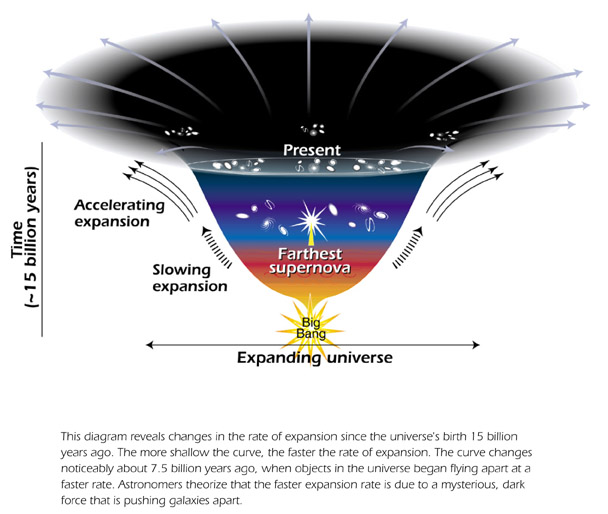
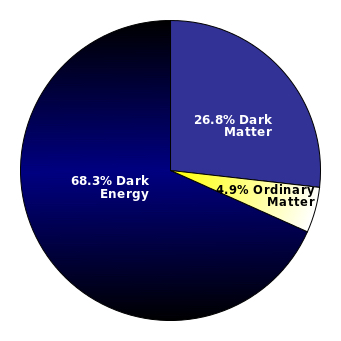
In modern cosmology, dark energy is a hypothetical energy form that is almost evenly distributed in everywhere of the universe and can drive a cosmic acceleration. However, it is extremely difficult to be detected directly. According to the standard LCDM model, dark energy accounts for about 70% of the entire universe and hence it can make a major contribution. There are currently many phenomenological models in explaining dark energy. The most representative and dramatic model is the cosmological constant that was introduced by Einstein when he studied the theory of general relativity. At that time, due to the technological limits of astronomical experiments, it was impossible for humans to know whether the universe was static or dynamic. He introduced a cosmological constant to yield a static cosmological solution. However, as Hubble discovered the expansion of the universe, Einstein soon abandoned this item and claimed that it was the biggest mistake in his life. Interestingly, a dramatic discovery was made in 1998, when two supernova observational teams independently found that our universe was accelerating, and then cosmologists picked up the cosmological constant from Einstein's trash box and used it to explain the observed phenomenon. However, since a cosmological constant is often interpreted as vacuum energy, it is difficult to extract suitable vacuum energy from quantum field theory that is consistent with current observations. Therefore, some alternative models of dark energy, such as Quintessence, Phantom, Quintom, Chameleons, as well as the Horndeski field and so on, were suggested by cosmologists under various physical motivations, and these models have made considerable progresses in current research.
暗物质 Dark Matter
在现代宇宙学中,暗黑宇宙占据了整个宇宙比分的约95%,除却暗能量还有一类极为难以被直接探测到的就是暗物质。暗物质几乎不参与任何已知的电磁作用、强弱相互作用,因此对它的探测主要是通过引力效应。早在1930年代,Fritz Zwicky通过使用维里定理推断出后发座星系团的内部有看不见的物质,也就是现在所说的暗物质。更为确凿的证据来自于星系旋转曲线的长期观测,这是女天文学家Vera Rubin在1970年代所作出的重大贡献。现代天文学可以通过引力透镜、宇宙大尺度结构的形成、微波背景辐射等多种实验方法来探测暗物质,并确认它约占据了整个宇宙比分的25%。然而,截止到目前,暗物质的粒子物理本质仍然是迷雾一团,尽管主流学说相信它是一类弱作用大质量粒子,但由于各国耗巨资开展实验并实验技术已接近于本底噪声仍未捕获到任何观测证据,于是其他替代模型如轴子、原初黑洞等正在获得越来越多的关注。对暗物质(和暗能量)的研究是现代宇宙学和粒子物理的重要课题。
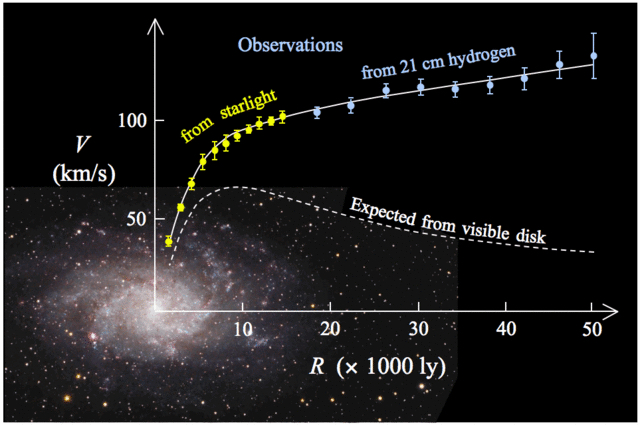
In modern cosmology, the Dark Universe accounts for about 95% of the entire universe. Except for dark energy, there exists another energy form, dubbed as dark matter, that is extremely difficult to be detected directly. Dark matter is hardly involved in any known electromagnetic, strong and weak interactions, and hence its detection is mainly through gravitational effects. As early as the 1930s, Fritz Zwicky used the Wiley theorem to infer that there might be invisible substances inside the constellation of the constellation, which is now called dark matter. More conclusive evidence comes from the long-term observations of the rotation curves of galaxies, in which a major contribution was made by the female astrophysicist Vera Rubin in the 1970s. In the era of modern astronomy dark matter can be detected via various experimental methods such as gravitational lensing, the large-scale structure survey, and cosmic microwave background radiations, which confirm that it accounts for about 25% of the entire universe. However, so far, the particle nature of dark matter remains a mystery. Although the prevailing viewpoint believes that dark matter is a kind of weakly interacting massive particles, major experimental efforts were made by various collaborations around the world and yet there is no conclusive evidence to prove its existence. In particular, considering that the sensitivities of these experiments have been very close to the background noise of solar neutrinos, it becomes very challenging for experimentalists to continue along this line. Instead, many other alternative models of dark matter were put forward and obtained more and more attention, namely, axions, primordial black holes and so on. The study of dark matter (as well as dark energy) is an important topic in the interdisciplinary field between modern cosmology and particle physics.
暴胀宇宙 Inflation
在现代宇宙学中,传统的热大爆炸宇宙学面临着一系列理论问题,包括:为什么宇宙在各个方向都高度雷同,即各向同性?为什么宇宙微波背景辐射会那么均匀分布?为什么宇宙空间是那么平坦?为什么没有探测到粒子物理理论所预言的磁单极子?宇宙大尺度结构形成的起源来自何处?为了解释这一系列疑难,Alan Guth于1980年提出了一个一揽子方案,即暴胀学说。有趣的是,第一个实现暴胀的理论模型却是Alex Starobinsky于1978年利用R^2修改引力提前实现,并截止到目前是与宇宙学观测数据最吻合的模型。暴胀学说认为,宇宙在大爆炸后约10^{-36}-10^{-32}秒的短暂时间内经历了剧烈的加速膨胀,并且单位空间体积被放大了约10^{78}倍。在暴胀时期的宇宙量子涨落,经过暴胀本身放大至宇宙级大小,成为了大尺度结构形成的种子,这就解释了宇宙宏观结构的形成。与此同时,宇宙的空间曲率、可能存在的磁单极子都会因为暴胀而被稀释一净,从而对今天的宇宙学观测并不敏感。由于暴胀是一个有效理论观点,它存在一些固有问题,例如它无法解释大爆炸时的宇宙奇点、在暴胀初期存在比普朗克长度还要小的扰动波长破坏了扰动理论的有效性、暴胀场的微观解释尚未明确,这些都是极早期宇宙研究中的核心问题。

As the standard model of modern cosmology, the hot big bang cosmology faces a series of conceptual issues, including: Why is the background universe highly isotropic? Why is the temperature of cosmic microwave background radiations so evenly distributed? Why is the space of the universe so flat? Why couldn't we observe monopoles that were predicted by many theories of particle physics? Where do the seeds of the large-scale structure formation arise from? To address these questions, Alan Guth proposed the theoretical scenario of inflationary cosmology in 1980. Interestingly, the very first inflation model was put forward in advance by Alexei Starobinsky, who applied a R^2 modification to GR in 1978, and remarkably it is so far one of the best models precisely consistent with the present cosmological observations. According to inflationary cosmology, our universe has experienced a dramatical acceleration within a short period of about 10^{-36}-10^{-32} seconds after the big bang, during which a unit space volume was enlarged by about 10^{78} times. During inflation, primordial density fluctuations can be quantum mechanically generated and soon become squeezed into classical perturbations, and therefore, inflationary cosmology provides a causal mechanism for the formation of the large-scale structure of the universe. Moreover, the spatial curvature and unwanted monopoles could be diluted by inflation and thus are not sensitive to current cosmological observations. However, since inflation is an effective point of view about the very early universe, there remain several conceptual issues. For example, it cannot explain the big bang singularity of the universe; the physical wavelength could have been even shorter than the Planck length at the beginning moment of inflationary phase; additionally, the microscopic interpretation of inflaton field remain a mystery. All these questions are core issues for the research of the very early universe.
反弹宇宙 Bounce Cosmology
现代宇宙学标准模型,又被称为热大爆炸宇宙学,自1940年代被提出发展至今,为我们认知整个宇宙取得了空前成功。然而,无论是热大爆炸还是它的升级版暴胀宇宙学,都面临一个不可理解的问题,也就是我们的宇宙诞生于约138亿年前的一个时空奇点,这无论是物理上还是数学上都难以理解。这意味着,暴胀本身是不完整的理论:我们不知道暴胀如何开始,也不知道暴胀前发生了什么。在这个背景下,一系列替代理论应运而生,其中最具代表性的就是反弹宇宙学。在反弹宇宙图像中,大爆炸之前的宇宙曾经历过一个收缩过程,它的单位体积会变得越来越小,直到某一时刻宇宙收缩到一个极小值,然后反弹进入标准的热大爆炸膨胀阶段。由此可见,反弹学说的提出,不仅继承了热大爆炸宇宙学的成功之处,还避免了那个会让宇宙学家头皮发麻的时空奇点。因此,它进一步推动了热大爆炸宇宙学的理论发展。有关反弹宇宙的研究最早可以追溯到1930年代Tolman,而有关它的扰动理论以及合理的模型构造都是近些年宇宙学研究的热门话题。
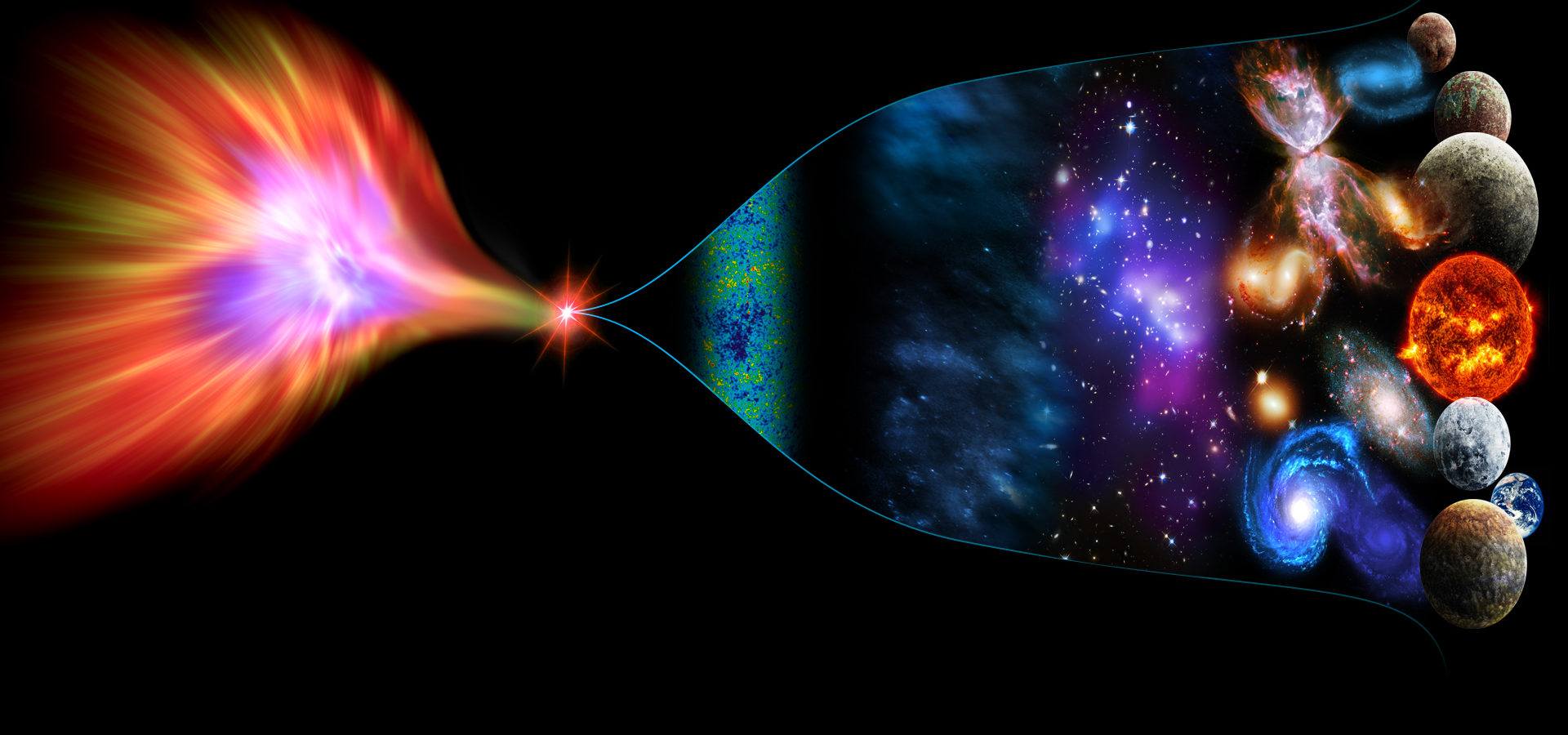
The standard model of modern cosmology, also known as the hot big bang cosmology, can be traced back to the 1940s and has achieved unprecedented successes in the understanding of the entire universe. However, both the big bang and its upgraded version, known as inflationary cosmology, face a severe problem, that is, our universe was born in a singularity of space and time about 13.8 billion years ago, which has failed to be explained by any known dictionaries of physics or mathematics. This means that big bang and inflation are incomplete theories: we don't know how the universe starts the evolution, nor what has happened before the singular beginning. In this context, a series of alternative theories appeared, among which the most representative one is bounce cosmology. In the picture of bounce cosmology, the universe has experienced a phase of contraction before the bounce, and its unit volume would become smaller and smaller until the universe evolved to a minimum size at a certain moment, and then bounced into the standard expansion of hot big bang. Consequently, bounce cosmology not only inherits the successes of the hot big bang cosmology, but also avoids the initial singularity issue. In this regard, it has further improved theoretical developments of the hot big bang cosmology. The research on bounce cosmology may be traced back to Tolman's works in the 1930s. However, the underlying perturbation theory and reasonable model constructions are still hot topics in modern cosmology.
修改爱氏引力理论 Beyond Einstein
1915年爱因斯坦提出广义相对论,这个描述万有引力的物理理论迅速成为了现代物理学的基石之一。从微观的原子尺度到宏观的太阳系尺度,目前还没有哪一个与引力相关的现象是不能被广义相对论所解释的。然而伴随着上世纪天文学家意识到星系旋转曲线与可见物质所带来的引力效应不相符,以及宇宙学观测表明当前的宇宙正在经历加速膨胀,修改爱氏引力理论的课题被提上了日程。有一批引力物理学家认为,或许暗物质和暗能量不一定存在,即便存在他们的比分也未必那么多,于是在宇宙大小的尺度上他们期待通过修改引力性质来解释这些观测现象。另一方面,从理论的发展考虑,物理学家相信引力理论最终将发展出某一个合理的量子版本,尽管到目前大家还在盲人摸象,但在半经典处理下一些量子效应可能带来的修改引力模型已被陆续提出,例如第一个实现暴胀的理论模型就是一个修改爱氏引力模型。而2015年人类首次发现引力波之后,引力波天文学和引力波宇宙学时代的来临更是将对修改爱氏引力理论的各种检验推向了当前的宇宙学研究的高潮。
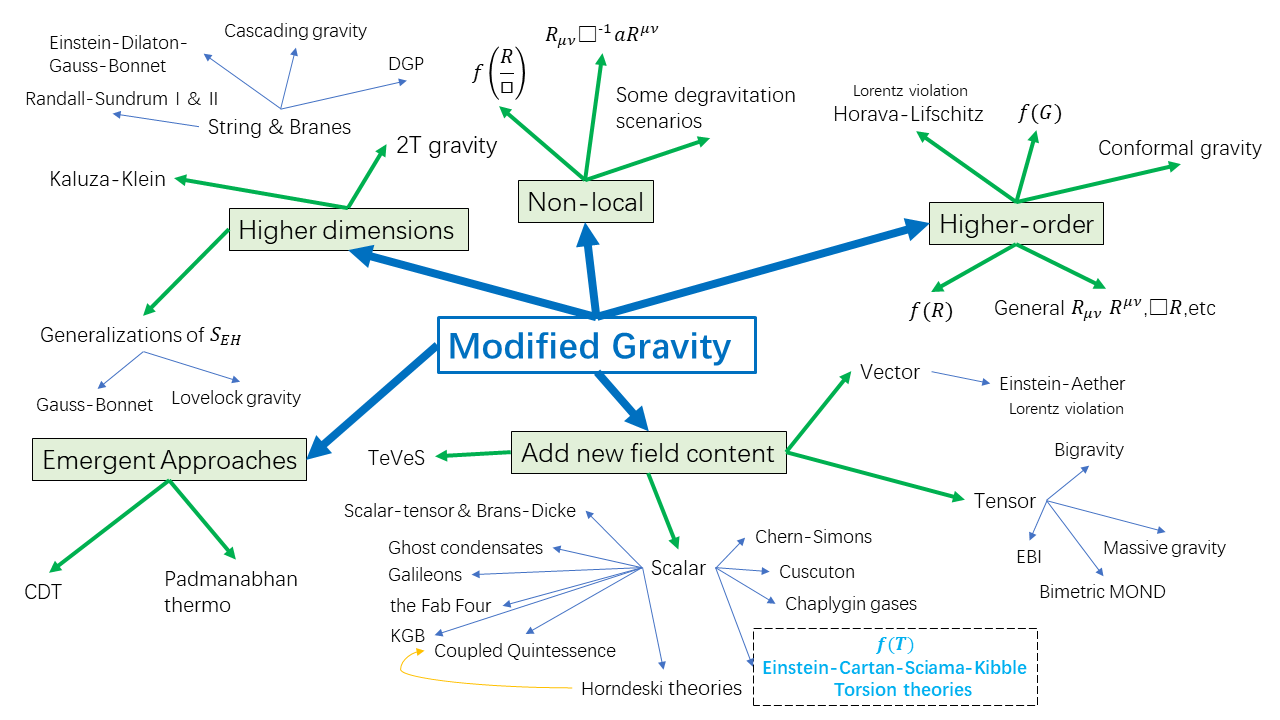
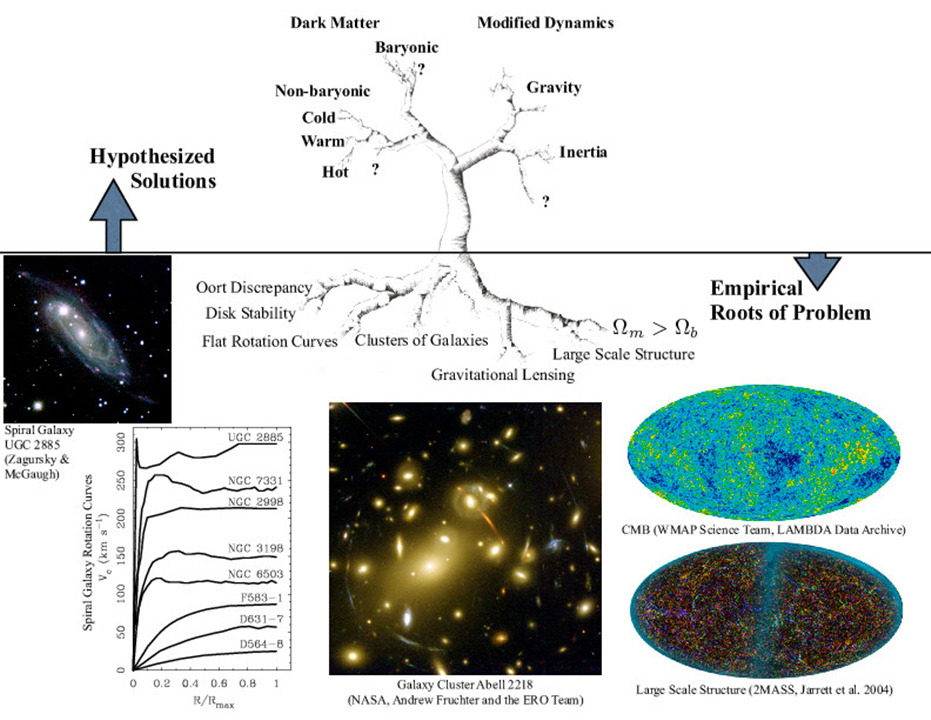
Since Einstein proposed general relativity in 1915, this theory about gravitation has soon become one of the cornerstones of modern physics. It successfully described all physics related to gravity from the microscopic atomic scale to the macroscopic solar system. However, along with the astronomical discoveries of abnormal rotation curves of galaxies and cosmic acceleration at present, the topic of gravitational theories beyond Einstein has become attractive to many physicists. A group of gravitational physicists believe that dark matter and dark energy may not necessarily exist. Instead, they expect to explain these observations by modifying GR on cosmological scales. On the other hand, from the theoretical aspect, physicists believe that a theory of gravitation should eventually accommodate with a reasonable quantum version. Although we are far away from a theory of quantum gravity, some modified gravity models that may present quantum effects can be developed in semi-classical level, namely, the R^2 inflation model. Moreover, the direct detection of gravitational waves was achieved by the LIGO collaboration in 2015. This great discovery announced the beginning of gravitational wave astronomy as well as gravitational wave cosmology that pushed the experimental tests of gravitational theories beyond Einstein into extremely high precision.






